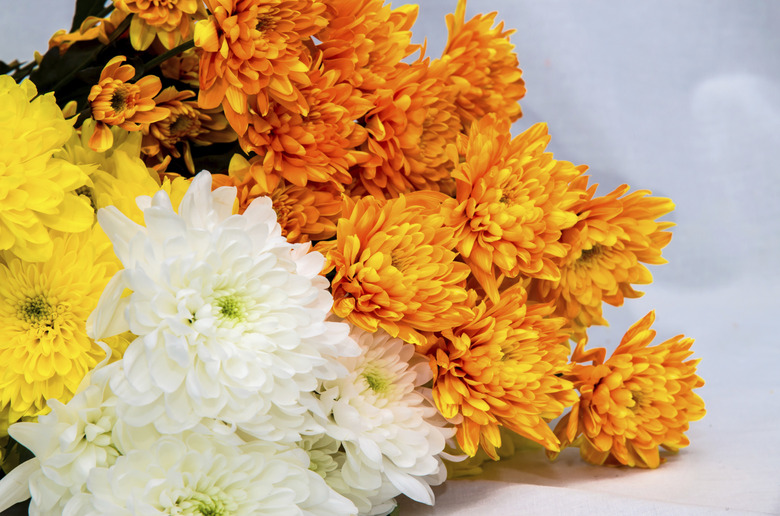How To Propagate Mums The Easy Way
Garden chrysanthemums or garden mums (Chrysanthemum x morifolium or Dendranthema x grandiflora), the perennial varieties most widely available in autumn, vary from less than 1 foot to 6 feet in height. With fleshy, lobed leaves and single or double flowers from 1 to 6 inches wide, they range in hardiness from U.S.
Garden chrysanthemums or garden mums (Chrysanthemum x morifolium or Dendranthema x grandiflora), the perennial varieties most widely available in autumn, vary from less than 1 foot to 6 feet in height. With fleshy, lobed leaves and single or double flowers from 1 to 6 inches wide, they range in hardiness from U.S. Department of Agriculture plant hardiness zones 4 through 10. Most are hybrids and don't produce plants like them from their seeds. Cuttings taken from them, however, root easily in either water or soil.
Take Cuttings
Because chrysanthemums often are planted in autumn so have little time to become established, they frequently don't survive winter, even in USDA zones where they are considered hardy. One way to preserve those plants is to root their cuttings indoors and plant the resulting new plants outdoors in spring. You also can take cuttings from established chrysanthemums after they put out new growth in spring. Wait until the shoots are at least 6 inches tall, and then snip off the top 4 inches of several shoots, severing each one just below a leaf node — the point from which a leaf will grow. Remove the lowest leaves from each cutting.
- Garden chrysanthemums or garden mums (Chrysanthemum x morifolium or Dendranthema x grandiflora), the perennial varieties most widely available in autumn, vary from less than 1 foot to 6 feet in height.
- Because chrysanthemums often are planted in autumn so have little time to become established, they frequently don't survive winter, even in USDA zones where they are considered hardy.
Root the Cuttings
The cuttings can be rooted in water or soil. If you wish to root them in water, then place them in a small, waterproof container, such as a jelly jar, juice glass or small vase. Add about 1 inch of water to the container, ensuring that the remaining leaves are above the water surface.
Rooting cuttings in soil instead requires filling a pot — that has bottom drainage holes — with a soil mixture that is 1 part sand and 1 part peat moss. Insert the bare base of each cutting into the mixture, tamping the mixture around the cutting so it covers at least one leaf node and so the cutting stands upright. The cuttings need to be planted far enough apart to prevent their leaves from touching.
Place the container of water or pot containing your cuttings on a windowsill that receives bright, indirect light and is in a warm location. Until the cuttings root in about two weeks, either keep their pot's soil mixture damp or add water as necessary to maintain its 1-inch level in their container of water.
- The cuttings can be rooted in water or soil.
- Until the cuttings root in about two weeks, either keep their pot's soil mixture damp or add water as necessary to maintain its 1-inch level in their container of water.
Make Divisions
After one of your hardy chrysanthemums has spread to cover a wide area, you can make several more plants by dividing it. Simply dig up the plant about one month after the date of your location's last average annual spring frost, and use a garden spade to cut the plant into 1-foot-square sections. Each section should be planted at least 1 1/2 to 2 feet apart and at the same depth at which it grew before. Mums require slightly acidic soil and full-sun exposure.
Sow Seeds
You may be able to find tiny, tan seeds at the bases of your chrysanthemums' petals if you allow the flower heads to mature and dry on the plants before pulling out those petals. Not all hybrids set seeds, however, and mums purchased in autumn may not have time to set seeds before freezing temperatures arrive. Also, as mentioned previously, hybrids' seeds won't result in plants that look exactly like the parent plants. Dry the seeds on paper towels, store them in paper envelopes and plant them in spring four months before you want the plants to bloom. Start seeds indoors by filling a container, which has bottom drainage holes, with damp seed-starting mix, and press the seeds into the mix's surface without covering them. After capping the container with plastic wrap to preserve the mix's moisture, keep it 65 to 70 degrees Fahrenheit until the seeds germinate, which usually takes 10 to 15 days.
- After one of your hardy chrysanthemums has spread to cover a wide area, you can make several more plants by dividing it.
- After capping the container with plastic wrap to preserve the mix's moisture, keep it 65 to 70 degrees Fahrenheit until the seeds germinate, which usually takes 10 to 15 days.
References
- PostCrescent.com, Post-Crescent Media: Yard MD Blog — Overwintering Mums
- Mother Earth News: Easy Plant Propagation
- The Complete Guide to Saving Seeds; Robert Edward Gough and Cheryl Moore-Gough
- National Chrysanthemum Society, USA: Frequently Asked Questions
- Purdue University Cooperative Extension Service: Chrysanthemums
- University of Illinois, Faculty Publications: Plant Breeding as a Hobby
- The New Sunset Western Garden Book; Kathleen Norris Brenzel, Editor
- The Plant Book; Susan Page and Margaret Olds, Editors
